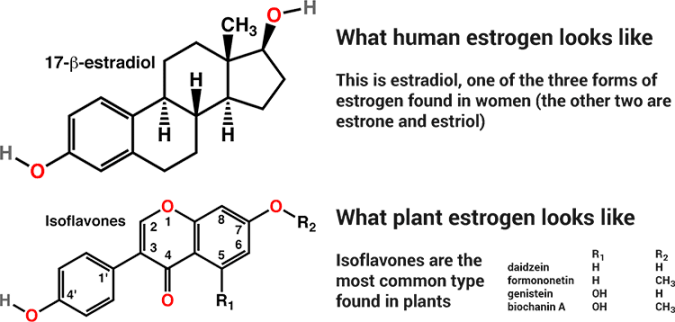This post is in response to a reply I received on my recent post Tofu or Not to Tofu where I highlight some of the recent evidence linking long-term consumption of tofu with cognitive decline. The author of the comment took issue with the comparison between estrogens and phytoestrogens. I personally do not believe arguing openly online is appropriate, so in an effort to be kind, I have deleted the comment but will respond to the content of it.
“Phytoestrogen and mammalian estrogen are completely different.”
Answer: Yes and No. The structure of mammalian estrogen and plant estrogens are different if compared molecule for molecule; however, looking at the structures you can see the similarities between the two compounds. In biochemistry, structure equals function, and phytoestrogens can activate mammalian estrogen receptors in the same way as endogenous estrogen.

Photo Credit: https://www.superfoodly.com/estrogen-foods-list-50-high-phytoestrogen-sources/

Image Credit: http://rexflavone.com/phytoestrogens/
“Phytoestrogen is not in any way a threat to human health the way estrogen is, because the human body does different things with them (since they are different compounds after all).
“Phytoestrogen is not a sex hormone from a mammal, which estrogen is; so when consumed we don’t increase risk of the cancers, heart disease, diabetes, hormonal problems, weight problems, digestion problems, or skin problems that we do when consuming estrogen.”
There are several problems with the statement above. Stating that phytoestrogens are “not in any way a threat to human health,” ignores the evidence of a link between phytoestrogens and memory decline as referenced in my previous post. It also fails to acknowledge the varied and often conflicting human clinical studies addressing not only the safety and but also the efficacy of phytoestrogens in a wide range of conditions.
The commenter above claims that because phytoestrogens are not endogenous sex hormones they don’t increase risk of “cancers, heart disease, diabetes, hormonal problems, weight problems, digestion problems, or skin problems.”
So what does the peer-reviewed scientific literature say?
In a more recent review of the scientific literature on phytoestrogens, Sirotkin and Harrath, address some of the many potential benefits and risks of dietary phytoestrogens. Let’s take this point by point.
Cancer. The soy isoflavone genistein has been shown to have anti-cancer properties in animal models. Population studies in Japan and China imply a lower incidence of prostate and breast cancers in eaters of traditional soy products. There is also evidence that soy isoflavones may help prevent colon, endometrial, and ovarian cancers. The studies surrounding breast cancer and phytoestrogens with some studies implying safety, others not, and many being equivocal.
Heart Disease. Cell and population studies demonstrate that phytoestrogens may be protective against cardiovascular disease through a variety of mechanisms. Unlike natural estrogens, phytoestrogens are also less likely to contribute to blood clots. Despite these promising findings, clinical studies that involve human subjects have failed to demonstrate any appreciable effects on arteriosclerosis and other cardiovascular diseases.
Diabetes and Obesity. The isoflavone genistein (the primary phytoestrogen in soy) has been shown to stimulate replication of pancreatic beta cells in cell studies, which are lost in diabetes. Genistein has also been shown to influence the life cycle of the fat cell and inhibit inflammation and oxidative stress associated with obesity. Both long and short-term human studies have shown conflicting results with most authors unable to make definitive claims or recommendations. As Talaei and Pan conclude, “Although the widespread use of phytoestrogens could not be recommended due to the controversies, habitual consumption of phytoestrogens, particularly their intact food sources like soy and whole flaxseed, could be considered as a component of an overall healthy dietary pattern for prevention and management of T2D.”
Skin. Phytoestrogens like estrogen exert an anti-aging effect on the skin through the estrogen receptor. Human studies comparing oral and topical formulations of the isoflavone genistein with estrogen have been promising with results implying increased dermal thickness, better vasculature and decreased fine lines in both groups. Of note, topical formulations of phytoestrogens did not demonstrate body-wide effects, which could have deleterious effects.
Digestion. Phytoestrogens in combination with probiotics are hypothesized to increase the production of the biochemicals equol, enterolignans, and urolithins, which are considered protective against chronic diseases related to aging. Human studies supporting these benefits are lacking.
Conclusions. Any compound whether natural or endogenous has the potential to produce a wide range of effects on human health and physiology. Natural does not always mean safe or better. All of us must be cautious when choosing what we put into our bodies whether it is a supplement or a food. The potential benefits of specific phytoestrogens for human health are interesting and encouraging. Given the evidence as it stands today, I personally could not recommend consumption of supplements or products high in phytoestrogens. Be wise. Be informed. And above all, be kind.
References:
Sirotkin, Alexander V., and Abdel Halim Harrath. “Phytoestrogens and their effects.” European journal of pharmacology 741 (2014): 230-236.
Talaei, Mohammad, and An Pan. “Role of phytoestrogens in prevention and management of type 2 diabetes.” World journal of diabetes 6.2 (2015): 271.
Irrera, Natasha, et al. “Dietary management of skin health: The role of genistein.” Nutrients 9.6 (2017): 622.
Landete, José María, et al. “Probiotic Bacteria for Healthier Aging: Immunomodulation and Metabolism of Phytoestrogens.” BioMed research international 2017 (2017).






